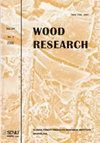COLOR DIVERSITY OF BEECH WOOD WITH A FALSE HEARTWOOD IN THE COLOR SPACE CIE L*a*b*
IF 1
4区 农林科学
Q3 MATERIALS SCIENCE, PAPER & WOOD
引用次数: 0
Abstract
The color of the false heartwood of Fagus sylvatica L. perceived by the human eye is in a wide range of shades from light brown-yellow to red-brown. The article analyzes the color in the color space CIE L*a*b* of dry wood of the false heartwood type: round, flame, star and marble. The color of the wood was measured with a colorimeter Color reader CR-10. The most colorful is the wood marble with a false heartwood. The results of statistical processing of the measured color values of dry beech wood, marble false heartwood on a planed surface identify it with values on the lightness coordinate L* = 65.2 ± 6.9 and on the chromatic coordinates: red color a* = 13.2 ± 2.3 and yellow b* = 19.2 ± 1.9. The most homogeneous in color is the color of the ring wood of the false heartwood with the coordinate values: L* = 63.7 ± 3.1; a* = 12.6 ± 1.7 and b* = 20.1 ± 1.6. The color diversity of the darkness and yellow-brown-red shades of the wood of the false heartwood is numerically quantified by the values of the total color difference ΔEsx* = 3.9 - 7.5. The presented values of the color of false heartwood beech complement the knowledge about the color of false heartwood and by defining the boundaries of color in the color space CIE L*a*b*, they create space for designers to model the color diversity of compositions and construction-joinery products made of sapwood and false heartwood beech.榉木与假心木在色彩空间 CIE L*a*b* 中的色彩多样性
人眼能感知的假心材颜色范围很广,从浅棕黄色到红棕色。文章分析了假心材类型(圆形、火焰形、星形和大理石形)的干燥木材在色彩空间 CIE L*a*b* 中的颜色。木材的颜色是用色度计 Color reader CR-10 测量的。颜色最鲜艳的是假心材大理石木材。对刨光表面的干榉木、大理石假心材的测量颜色值进行统计处理的结果表明,其亮度坐标值 L* = 65.2 ± 6.9,色度坐标值为:红色 a* = 13.2 ± 2.3,黄色 b* = 19.2 ± 1.9。颜色最均匀的是假心材的环木颜色,其坐标值为L* = 63.7 ± 3.1;a* = 12.6 ± 1.7 和 b* = 20.1 ± 1.6。假心材木材的深色和黄褐-红色色调的颜色多样性是通过总色差 ΔEsx* = 3.9 - 7.5 的数值来量化的。所提供的榉木假心材颜色值补充了有关假心材颜色的知识,并通过定义颜色空间 CIE L*a*b* 中的颜色边界,为设计师提供了空间,以模拟由边材和假心材榉木制成的组合和建筑连接产品的颜色多样性。
本文章由计算机程序翻译,如有差异,请以英文原文为准。
求助全文
约1分钟内获得全文
求助全文
来源期刊

Wood Research
工程技术-材料科学:纸与木材
CiteScore
2.40
自引率
15.40%
发文量
81
审稿时长
5.4 months
期刊介绍:
Wood Research publishes original papers aimed at recent advances in all branches of wood science (biology, chemistry, wood physics and mechanics, mechanical and chemical processing etc.). Submission of the manuscript implies that it has not been published before and it is not under consideration for publication elsewhere.
 求助内容:
求助内容: 应助结果提醒方式:
应助结果提醒方式:


